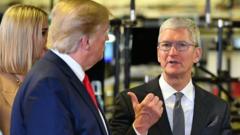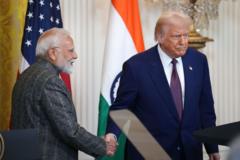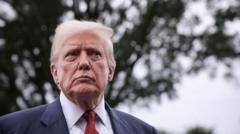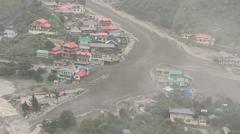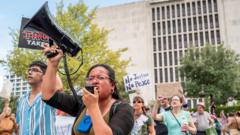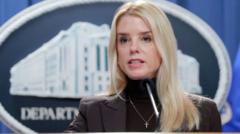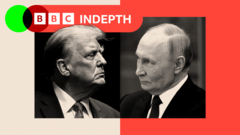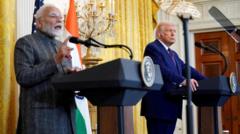The relationship between India and the United States has reached a new low following President Trump's imposition of 50% tariffs on Indian imports, aiming to penalize Delhi for its continued purchases of Russian oil. Once praised as allies, the discord raises serious questions about the future of trade ties and diplomatic engagements between the two nations.
**India-US Relations in Turmoil: Trump's New Tariffs Spark Diplomatic Crisis**
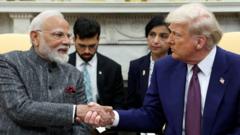
**India-US Relations in Turmoil: Trump's New Tariffs Spark Diplomatic Crisis**
Exacerbating tensions between India and the US, President Trump imposes hefty tariffs on Indian goods amidst accusations of India supporting Russia's war efforts.
In a surprising escalation of economic tensions, President Donald Trump has implemented an additional 25% tariff on goods imported from India, citing the country's ongoing oil purchases from Russia as a key factor in this decision. This development marks a drastic turnaround in what was once viewed as a burgeoning partnership, especially considering that Indian Prime Minister Narendra Modi was welcomed in Washington shortly after Trump's second term commenced with promises of stronger trade relations, including a goal to double bilateral trade to $500 billion by 2030.
Current discourse, however, has taken a gloomy turn, with Trump labeling India's economy as "dead" and implementing tariffs that his administration deems necessary to deter India from funding Russia’s military endeavors in Ukraine. This has led the Indian government to characterize the tariffs as "unfair, unjustified, and unreasonable."
While Modi’s government has largely restrained its responses in hopes of salvaging diplomatic relations, the landscape appears significantly altered. The tensions are compounded by Trump's recent engagements with Pakistan, another territorial rival of India, which have also soured perceptions in Delhi regarding US reliability as a partner.
Experts suggest that this strain in relations stems from deeper geopolitical considerations, with Trump's harsh stance likely serving as a negotiation tactic to secure more favorable terms from India regarding access to its agricultural sector. In light of its substantial demographic and economic stakes, India has been reluctant to concede to pressure that compromises its agricultural integrity and economic security.
This predicament places Modi in a difficult position, requiring the balancing act between pursuing a beneficial trade agreement and bolstering nationalist sentiments back home. Observers note that Delhi has begun to assert itself more firmly, emphasizing the importance of national interests amidst calls for further dialogue.
Despite these rising tensions, there are still prospects for collaboration between India and the US, particularly in sectors like technology, defense, and space exploration. The two nations recently made strides in launching a satellite jointly, signifying that not all pathways of cooperation are barred.
As such, while the immediate dynamics between India and the US seem strained, the foundational partnerships built over decades in various sectors suggest that both countries may ultimately find a way to reconcile their differences, though it may take considerable time and diplomatic efforts. In a climate fraught with uncertainty, the response from both nations will be pivotal in determining the trajectory of future relations.




